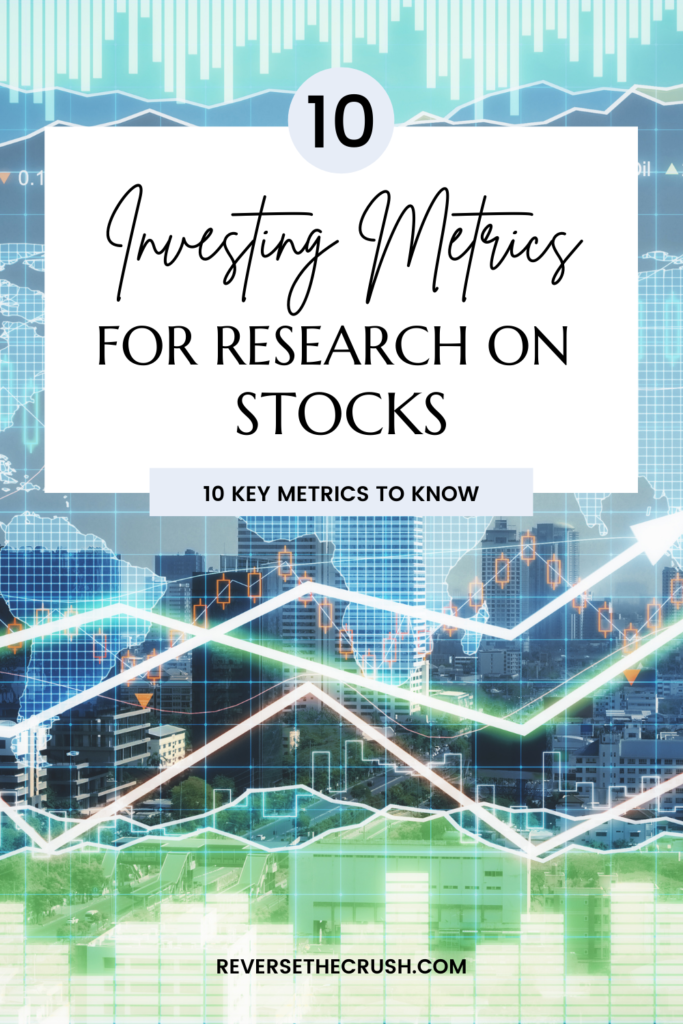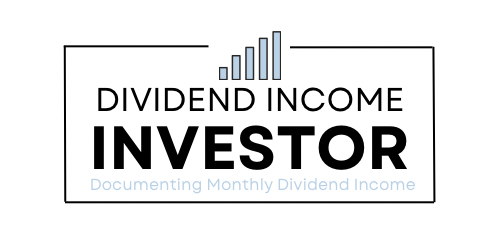Investing metrics for research on stocks: 10 key metrics for stock analysis. These important metrics help investors know which stocks to buy and how to profit.
It would be nice if investing was as simple as buying a stock based on a stock tip or article you read.
However, there’s a lot more to a successful investment operation.
“An investment operation is one which, upon thorough analysis, promises safety of principal and an adequate return. Operations not meeting these requirements are speculative.” ― Benjamin Graham, The Intelligent Investor
As such, I decided to write an article on the key investing metrics I use to analyze stocks.
In this article, I will show you 10 key metrics to use for research on stocks.
By the end of this article, you will know what each metric means and how to factor them into your own investment research.
Let’s dive in.
Investing Metrics For Research On Stocks

Investing Metrics For Research On Stocks: 10 Key Metrics To Know
1. P/E Ratio
P/E ratio stands for price to earnings ratio.
In short, the P/E ratio is one of the most important investing metrics of all.
When I am analyzing a stock, it’s one of the first metrics I look at.
It quickly allows you to get an idea of how cheap or expensive a stock is trading at relative to its earnings.
To calculate the price/earnings ratios, you simply need to find the company’s market capitalization and divide it by its earnings. Most brokers will do this for you, so you don’t even need to do the calculation yourself.
Ideally, I prefer to buy stocks trading at a P/E ratio of 15 or less. That usually indicates the stock is fairly valued or undervalued. However, in bull markets like today’s or with growth stocks, it’s unlikely that quality stocks will trade at less than 15 times earnings.
2. Payout Ratio
As a dividend income investor, the payout ratio is one of my favourite metrics.
The payout ratio tells me what percentage of the company’s earnings is being paid out to shareholders.
In other words, it will tell you if the company can afford to continue paying its dividend.
Although the dividend payout ratio will vary by industry, it’s usually not a good thing to see a company paying out over 100% of their earnings. Unless they are heavily investing back in the business or there was some one-off expense, a payout ratio of over 100% is not sustainable.
I view stocks like Apple Inc as the gold standard for payout ratios. Currently, Apple is paying out 18% of its earnings to shareholders. A payout ratio under 25% means that the company has plenty of room to continue to raise its dividend.
To calculate the payout ratio, you can divide the annual dividend by the company’s earnings. I typically use websites like Morningstar to determine the payout ratio.
3. P/B Ratio
P/B ratio stands for price to book ratio.
Essentially, the P/B ratio measures if a stock is over or undervalued relative to its book value per share.
To calculate the book value of each share, you need to divide a stock’s price by its book value per share.
A stock trading at a P/B ratio of 1 means it is trading at its book value. If it is trading at less than 1, it means the stock is trading at less than its book value. Conversely, if it is 1.1 or more, the stock price is above its book value.
Value investors typically aim to buy stocks trading at less than their book value, because they believe the market value will eventually catch up.
4. Beta
Beta is a measurement of risk compared to the stock market as a whole.
To be more precise, if a stock has a beta of 0.5, it will be half as volatile as the market. So, if the market drops by 1%, a stock with a beta of 0.5 will be expected to drop by only 0.05%.
Alternatively, a stock with a beta over 1 will have more volatility than the overall market.
If you are looking for less volatility, the best defensive dividend stocks have a beta of less than 1.
5. ROE
ROE stands for return on equity.
Return on equity (ROE) is a measure of a company’s profitability relative to shareholders’ equity.
Simply put, ROE is a metric that measures how much money a corporation is making with your money.
The most useful way to use this metric is to compare the ROE to companies within the same industry.
If you compare two companies in the same industry and one has a higher ROE, it is likely that the company with a higher ROE is a better investment.
To calculate ROE, you need to divide net income by average shareholder’s equity.
I usually let websites like Morningstar or my broker do this calculation for me.
6. P/S
P/S stands for price to sales ratio.
I don’t typically use this ratio unless I am analyzing growth stocks.
This is because growth stocks can be more challenging to analyze. They usually have outlandish P/E ratios that are based on the future earnings potential of a company. Furthermore, they usually are not profitable yet because they are reinvesting most of their revenue.
As such, for research on stocks like Palantir, I rely on the P/S ratio to get a better idea of how expense a stock price is relative to its sales.
To calculate the P/S ratio, divide a company’s market capitalization by its revenue.
7. EPS
EPS stands for earnings per share.
It is one of the most common investing metrics you will see in quarterly and annual stock reports.
In short, EPS calculates a company’s profit divided by the number of outstanding shares.
As an investor, the EPS amount tells you how much you earn for each share you own.
Once you know the earnings per share, you can compare it to the dividend per share and free cash flow per share.
It will give you an idea of the company’s cash flow and overall financial health.
If the EPS is high relative to the stock price, it means the company is earning a lot of money.
Furthermore, a high EPS number means the company has more income to grow the business.
If the company has a lot of free cash flow per share, they can use that money to increase the dividend, reinvest in the business, or grow earnings per share using more controversial methods such as share buybacks.
Personally, I am a fan of share buybacks because it increases my share of the pie. If a company uses its profit to buy back stock, it increases EPS because less shares are outstanding.
It’s like owning a small business with 3 people and then buying out one of the partners. If only 2 partners are left, you can divide the earnings by 2 owners instead of 3.
8. D/E Ratio
D/E stands for debt-to-equity ratio.
The D/E ratio is an important metric to determine a company’s financial positions. Basically, it will show you a company’s reliance on debt to fund its operations.
To determine a company’s D/E ratio, divide total liabilities by the shareholders’ equity (total assets – liabilities).
Keep in mind that most business will use debt fo finance operations, especially when interest rates are low. But having too much debt is never a good thing.
9. Net Margin %
Net margin is the amount of profit leftover over after all costs have been subtracted from revenue.
To calculate net margin percentage, subtract cost from revenue and divide by revenue.
I like to keep an eye on net margin with businesses I invest in because it’s a good indicator of the brand’s strength. Over time, competitors will eat into profits as they take away market share and costs rise. But if the company has a strong position and brand, they will have pricing power that allows them to continually raise prices of the products they sell.
10. Dividend Yield
Of course, I had to include dividend yield in this list of investing metrics for research on stocks—I’m a dividend investor.
The dividend yield shows investors how much dividend income they will receive relative to how much they invest.
To be more precise, the dividend yield is the annual amount dividend by the share price.
If you look at a company like ENB.TO, you will see that the dividend yield is 6.95%.
This is determined by dividing the annual dividend amount of $3.34 by the share price of $48.43.
Furthermore, the dividend yield is also a good metric to determine if a stock is undervalued or overvalued.
Stocks with low P/E ratios and high dividend yields tend to be undervalued. Meanwhile, stocks with low dividend yields could be undervalued. However, it depends on the industry. And in some cases, stocks with high dividend yields could be value traps. If they payout ratio is too high, they could be at risk of having to cut or slash the dividend.

Investing Metrics For Research On Stocks – Final Thoughts
In addition to these investment metrics for research on stocks, I also look at key indicators, branding, and management.
When I buy stocks, I typically use bollinger bands, which is a technical indicator that traders use.
For branding and management, research on stocks becomes more of an art. It requires careful examination of quarterly and annual reports, and close observation of comments and decisions by management.
It may seem like a complicated process at first, but once you look at 100 companies, the best companies will stand out.
Now I’d like to hear what investing metrics you use for research on stocks. Any metrics that I didn’t include in this post?
Related Articles On Investing
Best Stock Apps: 4 Must-Have Apps For Tracking Stock Prices
Dividend Payout Ratio – Dividend Investors Should Seek Healthy Ratios Over High Ratios
Best Investing Books To Read: 11 Books To Become A Better Investor
I am not a licensed investment or tax adviser. All opinions are my own. This post may contain advertisements by Monumetric. This post may also contain internal links, affiliate links to BizBudding, Amazon, Bluehost, and Questrade, links to trusted external sites, and links to RTC social media accounts.
Connect with RTC
Twitter: @Reversethecrush
Pinterest: @reversethecrushblog
Instagram: @reversethecrush_
Facebook: @reversethecrushblog
Email: graham@reversethecrush.com


 What Percentage Of Your Income Should Go To Retirement Savings?
What Percentage Of Your Income Should Go To Retirement Savings?
